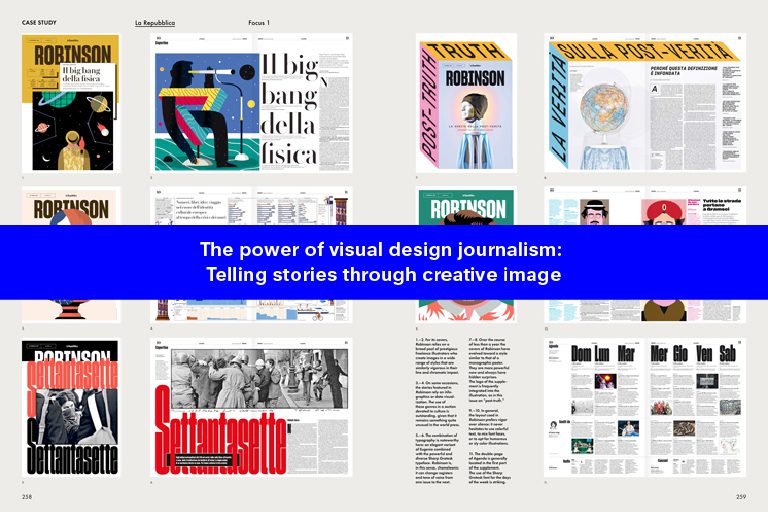The web has become a powerhouse of creative visuals today that share tales of global news. Internet changed the way we tell stories and social media has become the modern newsroom for GenZ and millennials. Brands place high value today on visual communications and their design. Bringing designers to the core of the whole storytelling process. Our technology’s reach and innovations have evolved the journalism landscape to become more visually engaging and immersive. Ever wonder about the amount of data we are exposed to daily and how we can consume it all too easily? It’s all thanks to the practice of visual design that breaks down complex news and information into easy-to-consume stories. Making narratives more engaging and accessible to keep the GenZ involved, who are known to have extremely short attention spans.
When visual design and journalism come together, we gain visual design journalism. A concept that has become an absolute must for many channels today. Even brands are adopting this medium to build on essential news they want to share via social media applications with their audience. Social media landscape is all about visual aids, words are simply not enough to tell a story anymore. To keep your brand relevant in these evolving times, designers and content creators need to understand the power of visual journalism. This form of journalism was born with the print media back in the late 90s and has since changed the way we seek and consume news. Humour, satire, and cartoons became an exceptionally popular form of news that only a few could master. It required expert design skills and catchy content to grab the attention of the reader. What started as weekly columns in newspapers today is our every-minute way to consume news. Short attention spans of the global audience today require designers and content creators to think of visually engaging ways to immerse their audience.
Also read: Essential design organizations in India every student must know
The rise of Visual design journalism
The advent of the internet disrupted the traditional news segment. Our news is no longer confined to word-based narratives, they are visually engaging stories that evoke emotions and drive meaningful engagement. In today’s world, with a growing population of active millennials and Gen Z, storytelling goes beyond word-based narratives. It now encompasses stories that deeply resonate with readers, keeping them engaged through creative imagery that conveys complex messages in an easily digestible format. Here are the reasons for the rise in visual design journalism:
– Short attention spans
– Changing reader preference from texts to visual infographics
– Evolving technology and social media landscape
– Global reach and accessibility
– Evolution in the process of storytelling, allowing visual journalism to express complex stories
– Data-driven storytelling, use of interactive graphics to make stats and numbers easy to consume and more relatable.
– Emotional and cultural connect. Creatives can help evoke emotions and a cultural connection, engaging more users who build a connection with the story.
Design techniques in visual journalism
Show, don’t tell – is the simple narrative visual journalism works on. Visual creatives with interesting type design are always more pleasing to the eye than paragraphs of text. Leveraging a cognitive advantage which means how our brains process information, visual design captures the attention of the viewers. Humans are visual creatures and a good visual journalism can offer them a storyline that cuts straight to the point.
Also read: Contemporary Indian design studios and their accomplished work
While this is utilized largely by news channels and start-ups, digital marketing across industries has also utilized this for captivating storytelling. This storytelling can be in the form of:
Animation.
This revolves around movement to grab attention in an effective manner to highlight key aspects. Helps to bring magic to the story. Motion graphics have become increasingly relevant in our society today as technology progresses and more short form of video content is becoming viral.
Scrollytelling.
This combines storytelling and scrolling. Designers work with multimedia to dynamically tell a story and allow the audience to unfold it one scroll at a time. With each scroll, it unlocks a new design feature that expands the story further. Keeping the viewer engaged and immersed. This is used by the likes of the Wall Street Journal and the New York Times.
Data Visualization.
This is used when brands want to share stats and numbers in a simplified manner. Designers work with visual aids of interactive maps, charts, and infographics to help the audience process data in a meaningful manner.
Good visual journalism should offer its audience:
– an immediate connect
– a lasting impression
– ease of shareability
– straight-to-the-point journalism that cuts the noise
Also read: Graphic Design trends dominating 2023 so far
Let’s take the example of the New Yorker magazine to learn the essential practices for success in design journalism:
The New Yorker Magazine
This magazine is known for its visual journalism. One that is impactful, cuts through the clutter, and brings captivating connections between world affairs and storytelling via design. Here are some critical features of their visual journalism:
a. Illustrative supremacy and excellent cover pages
They are globally known for their distinctive and signature illustrations that reflect events, societal issues, or cultural moments. The cover of the New Yorker is a visual commentary on the world that sparks conversations, and social media trends and generates a lot of interest from global communities. Their visuals are hand-drawn illustrations that are designed to complement the magazine’s written content.
b. Visual Essays
A unique feature of the New Yorker, these visual essays are a playful mix of text, images, and other interactive elements to engage users in a narrative. This form of storytelling enriches their content which ranges around contemporary issues and personal experiences.
c. Data visualization and creative layouts
The magazine uses charts, graphs, and infographics to effectively illustrate complex data. They present it as visually appealing narratives in creative layouts. These layouts are curated to incorporate a perfect blend of text and visuals.
d. Photography and artistic expression
The New Yorker photographers have a knack for capturing the essence of their subjects. Their visual design journalism allows artistic expression and designer interpretation of subjects. The multimedia designers, illustrators, photographers, and artists have the freedom to bring a unique perspective to the magazine’s content.
Also read: Latest trends shaping the automotive design sector
e. Evolving and consistency
The brand also believes in adapting with time. They adopt new technologies to encompass a broader audience, work with new design concepts, and remain relevant. The brand also embraces various interactive features like immersive web experiences. However, what makes them a design journalism marvel is their consistency of visual identity across their various platforms. Allowing their audience to instantly recognize the magazine content, differentiating it from its competition.
Content rich with visual aids and interactive media can help the brand keep its readers engaged in the narrative. In our digital world, visuals play a defining role in communicating a message. Designers must plan their story to map their visual needs and ensure that the written copy and visuals are aligned.
Also read: AI’s influence in UX Design: Redefining UX design



Want to Become a Designer ?
Strate is a unique design school that nurtures your talents as a designer by offering state-of-the art designing courses in Bangalore.
Join Strate